Large-Scale 3D Multi-Story Enterprise Layout Design in a New Type of Industrial Park in China
Abstract
:1. Introduction
- (1)
- How to define the enterprise association risk?
- (2)
- How to formulate a bi-level optimization model for the large-scale 3DMSELD problem?
- (3)
- How to solve the proposed nonlinear bi-level model?
2. Literature Review
2.1. Influencing Factors in Layout
2.2. Formulation of Association Risks
2.3. Bi-Level Optimization Model
2.4. Model Solving Algorithm
2.5. Summary
3. Problem Description
3.1. New-Type Clustered Industrial Park
3.2. Association Safety Risks
3.3. Profit
3.4. Goals
4. Bi-Level Programming Model Formulation
4.1. Notations
| . | |
| . | |
| . | |
| . | |
| . | |
| . | |
| . | |
| Area parameters | |
| . | |
| . | |
| . | |
| Risk parameters | |
| are adjacent. | |
| are adjacent. | |
| are adjacent. | |
| is the floor difference. | |
| is the floor difference. | |
| is the floor difference. | |
| Rent parameter | |
| . | |
| Other parameter | |
| . | |
4.2. Assumptions
- (i)
- An enterprise can be located on only one floor of a building. A few enterprises that need to be located on multiple floors are treated as independent enterprises.
- (ii)
- The associated safety risk can only occur between two enterprises when the two enterprises are located in the same building. This study does not consider the interactions between enterprises located in different buildings.
- (iii)
- The types of enterprises and the association risks of adjacent enterprises are known. The specific determination process is described in Section 3.
4.3. Bi-Level Integer Programming Model
5. Solution Strategy
6. Case Study
6.1. Data Introduction
6.2. Layout Result
6.3. Computational Results in Different Scenarios
6.3.1. Only the Profits Are Considered
6.3.2. Consider Current Layout
6.4. Sensitivity Analysis
6.4.1. Sensitivity to the Number of Risk Enterprises
6.4.2. Sensitivity to the Size of the Industry Park
7. Conclusions
Author Contributions
Funding
Institutional Review Board Statement
Informed Consent Statement
Data Availability Statement
Conflicts of Interest
References
- Wang, R.; Wu, Y.; Wang, Y.; Feng, X. An industrial area layout design methodology considering piping and safety using genetic algorithm. J. Clean. Prod. 2017, 167, 23–31. [Google Scholar] [CrossRef]
- Heikkilä, A.-M.; Malmén, Y.; Nissilä, M.; Kortelainen, H. Challenges in risk management in multi-company industrial parks. Saf. Sci. 2010, 48, 430–435. [Google Scholar] [CrossRef]
- Caputo, A.C.; Pelagagge, P.M.; Palumbo, M.; Salini, P. Safety-based process plant layout using genetic algorithm. J. Loss Prev. Process Ind. 2015, 34, 139–150. [Google Scholar] [CrossRef]
- Wang, R.; Wang, Y.; Gundersen, T.; Wu, Y.; Feng, X.; Liu, M. A layout design method for an industrial park based on a novel arrangement algorithm—Consideration of pipe network and multiple hazard sources. Chem. Eng. Sci. 2020, 227, 115929. [Google Scholar] [CrossRef]
- Wang, R.; Wang, Y.; Gundersen, T.; Wu, Y.; Feng, X.; Liu, M. A multi-objective optimization method for industrial park layout design: The trade-off between economy and safety. Chem. Eng. Sci. 2021, 235, 116471. [Google Scholar] [CrossRef]
- Şahin, R.; Niroomand, S.; Durmaz, E.D.; Molla-Alizadeh-Zavardehi, S. Mathematical formulation and hybrid meta-heuristic solution approaches for dynamic single row facility layout problem. Ann. Oper. Res. 2020, 295, 313–336. [Google Scholar] [CrossRef]
- Rosenblatt, M.J. The facilities layout problem: A multi-goal approach. Int. J. Prod. Res. 1979, 17, 323–332. [Google Scholar] [CrossRef]
- Penteado, F.D.; Ciric, A.R. An MINLP approach for safe process plant layout. Ind. Eng. Chem. Res. 1996, 35, 1354–1361. [Google Scholar] [CrossRef]
- Kia, R.; Khaksar-Haghani, F.; Javadian, N.; Tavakkoli-Moghaddam, R. Solving a multi-floor layout design model of a dynamic cellular manufacturing system by an efficient genetic algorithm. J. Manuf. Syst. 2014, 33, 218–232. [Google Scholar] [CrossRef]
- Latifi, S.E.; Mohammadi, E.; Khakzad, N. Process plant layout optimization with uncertainty and considering risk. Comput. Chem. Eng. 2017, 106, 224–242. [Google Scholar] [CrossRef]
- Sonta, A.; Dougherty, T.R.; Jain, R.K. Data-driven optimization of building layouts for energy efficiency. Energy Build. 2021, 238, 110815. [Google Scholar] [CrossRef]
- Wu, Y.; Wang, Y. A chemical industry area-wide layout design methodology for piping implementation. Chem. Eng. Res. Des. 2017, 118, 81–93. [Google Scholar] [CrossRef]
- Al-Zubaidi, S.Q.D.; Fantoni, G.; Failli, F. Analysis of drivers for solving facility layout problems: A Literature review. J. Ind. Inf. Integr. 2021, 21, 100187. [Google Scholar] [CrossRef]
- Ingole, S.; Singh, D. Unequal-area, fixed-shape facility layout problems using the firefly algorithm. Eng. Optim. 2017, 49, 1097–1115. [Google Scholar] [CrossRef]
- Wang, R.; Wu, Y.; Wang, Y.; Feng, X.; Liu, M. An Industrial Park Layout Design Method Considering Pipeline Length Based on FLUTE Algorithm. In Computer Aided Chemical Engineering; Eden, M.R., Ierapetritou, M.G., Towler, G.P., Eds.; Elsevier: Amsterdam, The Netherlands, 2018; Volume 44, pp. 193–198. [Google Scholar]
- Wang, R.; Zhao, H.; Wu, Y.; Wang, Y.; Feng, X.; Liu, M. An industrial facility layout design method considering energy saving based on surplus rectangle fill algorithm. Energy 2018, 158, 1038–1051. [Google Scholar] [CrossRef]
- Derhami, S.; Smith, J.S.; Gue, K.R. A simulation-based optimization approach to design optimal layouts for block stacking warehouses. Int. J. Prod. Econ. 2020, 223, 107525. [Google Scholar] [CrossRef]
- Brunoro Ahumada, C.; Quddus, N.; Mannan, M.S. A method for facility layout optimisation including stochastic risk assessment. Process Saf. Environ. Prot. 2018, 117, 616–628. [Google Scholar] [CrossRef]
- de Lira-Flores, J.A.; López-Molina, A.; Gutiérrez-Antonio, C.; Vázquez-Román, R. Optimal plant layout considering the safety instrumented system design for hazardous equipment. Process Saf. Environ. Prot. 2019, 124, 97–120. [Google Scholar] [CrossRef]
- Medina-Herrera, N.; Jiménez-Gutiérrez, A.; Grossmann, I.E. A mathematical programming model for optimal layout considering quantitative risk analysis. Comput. Chem. Eng. 2014, 68, 165–181. [Google Scholar] [CrossRef]
- Groth, K.M.; Hecht, E.S. HyRAM: A methodology and toolkit for quantitative risk assessment of hydrogen systems. Int. J. Hydrogen Energy 2017, 42, 7485–7493. [Google Scholar] [CrossRef]
- Cozzani, V.; Gubinelli, G.; Antonioni, G.; Spadoni, G.; Zanelli, S. The assessment of risk caused by domino effect in quantitative area risk analysis. J. Hazard. Mater. 2005, 127, 14–30. [Google Scholar] [CrossRef] [PubMed]
- Zhou, J.; Reniers, G.; Cozzani, V. Improved probit models to assess equipment failure caused by domino effect accounting for dynamic and synergistic effects of multiple fires. Process Saf. Environ. Prot. 2021, 154, 306–314. [Google Scholar] [CrossRef]
- Ejeh, J.O.; Liu, S.; Papageorgiou, L.G. An MILP model for safe multi-floor process plant layout using the domino hazard index. Process Saf. Environ. Prot. 2021, 148, 137–165. [Google Scholar] [CrossRef]
- Liu, A.; Wu, C.; Peng, X. Research on Area Risk Assessment for Chemical Park based on Domino Effect Model. Procedia Eng. 2012, 45, 47–52. [Google Scholar] [CrossRef]
- Ding, L.; Khan, F.; Ji, J. A novel approach for domino effects modeling and risk analysis based on synergistic effect and accident evidence. Reliab. Eng. Syst. Saf. 2020, 203, 107109. [Google Scholar] [CrossRef]
- Ni, Z.-j.; Wang, Y.; Yin, Z. Relative risk model for assessing domino effect in chemical process industry. Saf. Sci. 2016, 87, 156–166. [Google Scholar] [CrossRef]
- He, Z.; Weng, W. A dynamic and simulation-based method for quantitative risk assessment of the domino accident in chemical industry. Process Saf. Environ. Prot. 2020, 144, 79–92. [Google Scholar] [CrossRef]
- Lu, J.; Han, J.; Hu, Y.; Zhang, G. Multilevel decision-making: A survey. Inf. Sci. 2016, 346, 463–487. [Google Scholar] [CrossRef]
- Cao, C.; Liu, Y.; Tang, O.; Gao, X. A fuzzy bi-level optimization model for multi-period post-disaster relief distribution in sustainable humanitarian supply chains. Int. J. Prod. Econ. 2021, 235, 108081. [Google Scholar] [CrossRef]
- Yang, X.; Niu, D.; Sun, L.; Ji, Z.; Zhou, J.; Wang, K.; Siqin, Z. A bi-level optimization model for electric vehicle charging strategy based on regional grid load following. J. Clean. Prod. 2021, 325, 129313. [Google Scholar] [CrossRef]
- Che, A.; Zhang, Y.; Feng, J. Bi-objective optimization for multi-floor facility layout problem with fixed inner configuration and room adjacency constraints. Comput. Ind. Eng. 2017, 105, 265–276. [Google Scholar] [CrossRef]
- Martinez-Gomez, J.; Nápoles-Rivera, F.; Ponce-Ortega, J.M.; Serna-González, M.; El-Halwagi, M.M. Optimization of facility location and reallocation in an industrial plant through a multi-annual framework accounting for economic and safety issues. J. Loss Prev. Process Ind. 2015, 33, 129–139. [Google Scholar] [CrossRef]
- Nabli, H. An overview on the simplex algorithm. Appl. Math. Comput. 2009, 210, 479–489. [Google Scholar] [CrossRef]
- Xie, W.; Sahinidis, N.V. A branch-and-bound algorithm for the continuous facility layout problem. Comput. Chem. Eng. 2008, 32, 1016–1028. [Google Scholar] [CrossRef]
- Ahmadi, A.; Akbari Jokar, M.R. An efficient multiple-stage mathematical programming method for advanced single and multi-floor facility layout problems. Appl. Math. Model. 2016, 40, 5605–5620. [Google Scholar] [CrossRef]
- Kulturel-Konak, S.; Konak, A. A large-scale hybrid simulated annealing algorithm for cyclic facility layout problems. Eng. Optim. 2015, 47, 963–978. [Google Scholar] [CrossRef]
- Chalupa, D.; Nielsen, P. A simple and robust Monte Carlo hybrid local search algorithm for the facility location problem. Eng. Optim. 2019, 51, 832–845. [Google Scholar] [CrossRef]
- Chen, Y.; Jiang, Y.; Wahab, M.I.M.; Long, X. The facility layout problem in non-rectangular logistics parks with split lines. Expert Syst. Appl. 2015, 42, 7768–7780. [Google Scholar] [CrossRef]
- Balakrishnan, J.; Cheng, C.H.; Conway, D.G.; Lau, C.M. A hybrid genetic algorithm for the dynamic plant layout problem. Int. J. Prod. Econ. 2003, 86, 107–120. [Google Scholar] [CrossRef]
- Patsiatzis, D.I.; Knight, G.; Papageorgiou, L.G. An MILP Approach to Safe Process Plant Layout. Chem. Eng. Res. Des. 2004, 82, 579–586. [Google Scholar] [CrossRef]
- Vázquez-Román, R.; Lee, J.-H.; Jung, S.; Mannan, M.S. Optimal facility layout under toxic release in process facilities: A stochastic approach. Comput. Chem. Eng. 2010, 34, 122–133. [Google Scholar] [CrossRef]
- Cheng, M.-Y.; Lien, L.-C. A hybrid AI-based particle bee algorithm for facility layout optimization. Eng. Comput. 2012, 28, 57–69. [Google Scholar] [CrossRef]
- Xu, Y.; Wang, Z.; Zhu, Q. An Improved Hybrid Genetic Algorithm for Chemical Plant Layout Optimization with Novel Non-overlapping and Toxic Gas Dispersion Constraints. Chin. J. Chem. Eng. 2013, 21, 412–419. [Google Scholar] [CrossRef]
- Emami, S.; Nookabadi, A.S. Managing a new multi-objective model for the dynamic facility layout problem. Int. J. Adv. Manuf. Technol. 2013, 68, 2215–2228. [Google Scholar] [CrossRef]
- Izadinia, N.; Eshghi, K.; Salmani, M.H. A robust model for multi-floor layout problem. Comput. Ind. Eng. 2014, 78, 127–134. [Google Scholar] [CrossRef]
- Alves, D.T.S.; de Medeiros, J.L.; Araújo, O.d.Q.F. Optimal determination of chemical plant layout via minimization of risk to general public using Monte Carlo and Simulated Annealing techniques. J. Loss Prev. Process Ind. 2016, 41, 202–214. [Google Scholar] [CrossRef]
- Zhang, G.; Nishi, T.; Turner, S.D.O.; Oga, K.; Li, X. An integrated strategy for a production planning and warehouse layout problem: Modeling and solution approaches. Omega 2017, 68, 85–94. [Google Scholar] [CrossRef]
- Arnaout, J.-P. Worm optimization for the multiple level warehouse layout problem. Ann. Oper. Res. 2018, 269, 29–51. [Google Scholar] [CrossRef]
- Ikwan, F.; Sanders, D.; Hassan, M. Safety evaluation of leak in a storage tank using fault tree analysis and risk matrix analysis. J. Loss Prev. Process Ind. 2021, 73, 104597. [Google Scholar] [CrossRef]
- Luo, T.; Wu, C.; Duan, L. Fishbone diagram and risk matrix analysis method and its application in safety assessment of natural gas spherical tank. J. Clean. Prod. 2018, 174, 296–304. [Google Scholar] [CrossRef]
- May, W.G.; McQueen, W. Radiation from Large Liquefied Natural Gas Fires. Combust. Sci. Technol. 1973, 7, 51–56. [Google Scholar] [CrossRef]
- Modak, A.T. Thermal radiation from pool fires. Combust. Flame 1977, 29, 177–192. [Google Scholar] [CrossRef]
- Sivathanu, Y.R.; Gore, J.P. Total radiative heat loss in jet flames from single point radiative flux measurements. Combust. Flame 1993, 94, 265–270. [Google Scholar] [CrossRef]
- Wu, C.; Hao, H. Modeling of simultaneous ground shock and airblast pressure on nearby structures from surface explosions. Int. J. Impact Eng. 2005, 31, 699–717. [Google Scholar] [CrossRef]
- Brode, H.L. Blast Wave from a Spherical Charge. Phys. Fluids 1959, 2, 217–229. [Google Scholar] [CrossRef]
- Yang, X.; Shi, S.; Cheng, P. Forecast and Simulation of Peak Overpressure of TNT Explosion Shock Wave in the air. Blasting 2008, 25, 15–18. (In Chinese) [Google Scholar]
- Zhou, G.; Zhu, Z.; Luo, S. Location optimization of electric vehicle charging stations: Based on cost model and genetic algorithm. Energy 2022, 247, 123437. [Google Scholar] [CrossRef]
- Blickle, T.; Thiele, L. A Comparison of Selection Schemes Used in Evolutionary Algorithms. Evol. Comput. 1996, 4, 361–394. [Google Scholar] [CrossRef]
- Mühlenbein, H.; Schlierkamp-Voosen, D. Predictive Models for the Breeder Genetic Algorithm I. Continuous Parameter Optimization. Evol. Comput. 1993, 1, 25–49. [Google Scholar]
- Jazzbin, e.a. Geatpy: The Genetic and Evolutionary Algorithm Toolbox with High Performance in Python. Available online: http://www.geatpy.com/ (accessed on 2 March 2022).

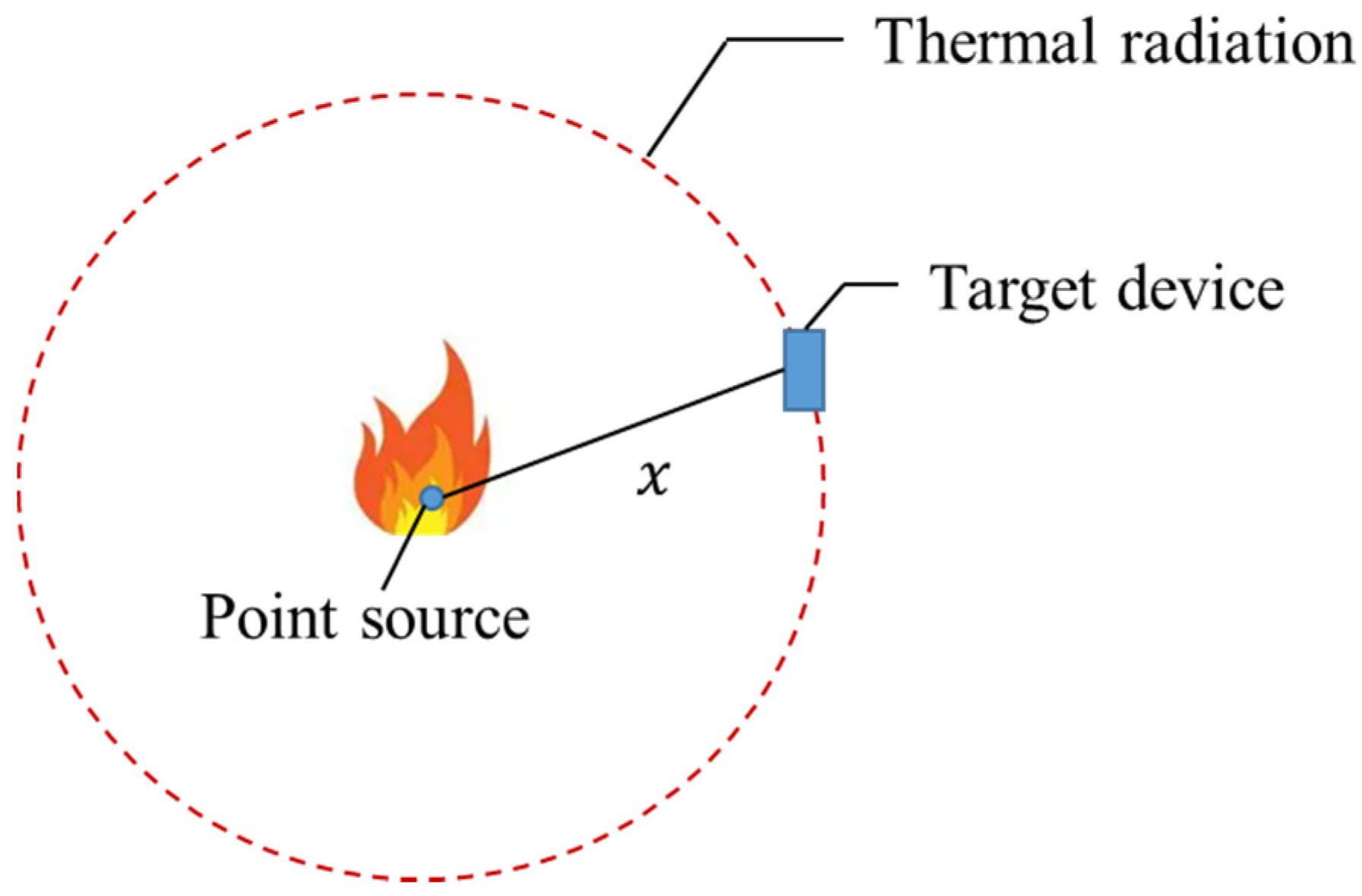

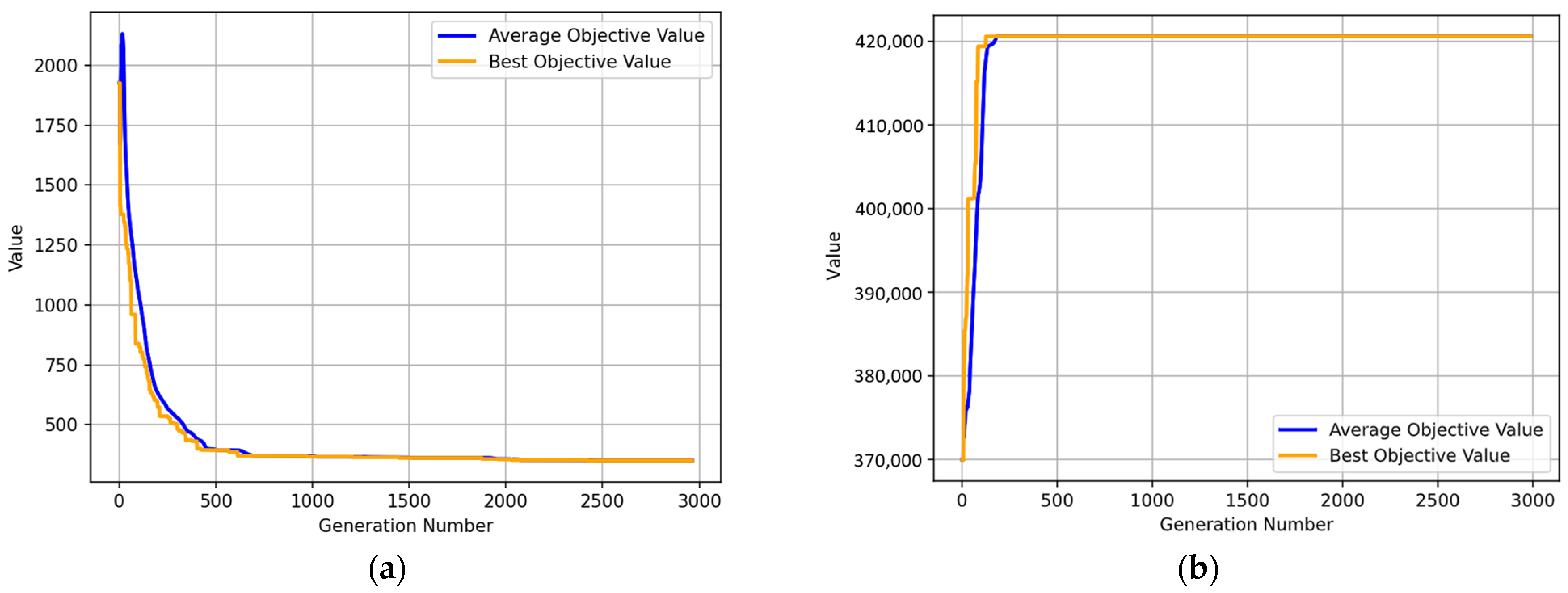

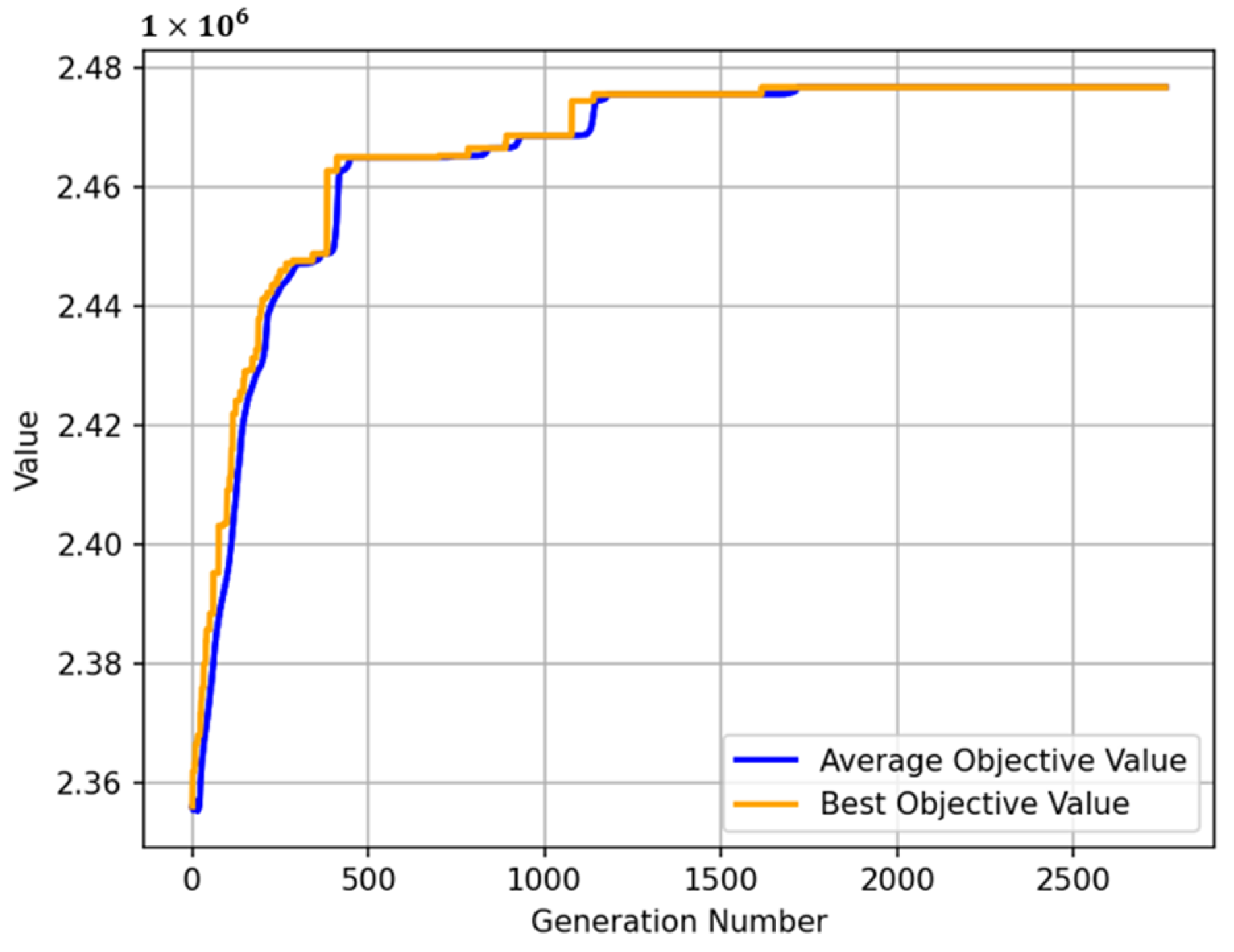
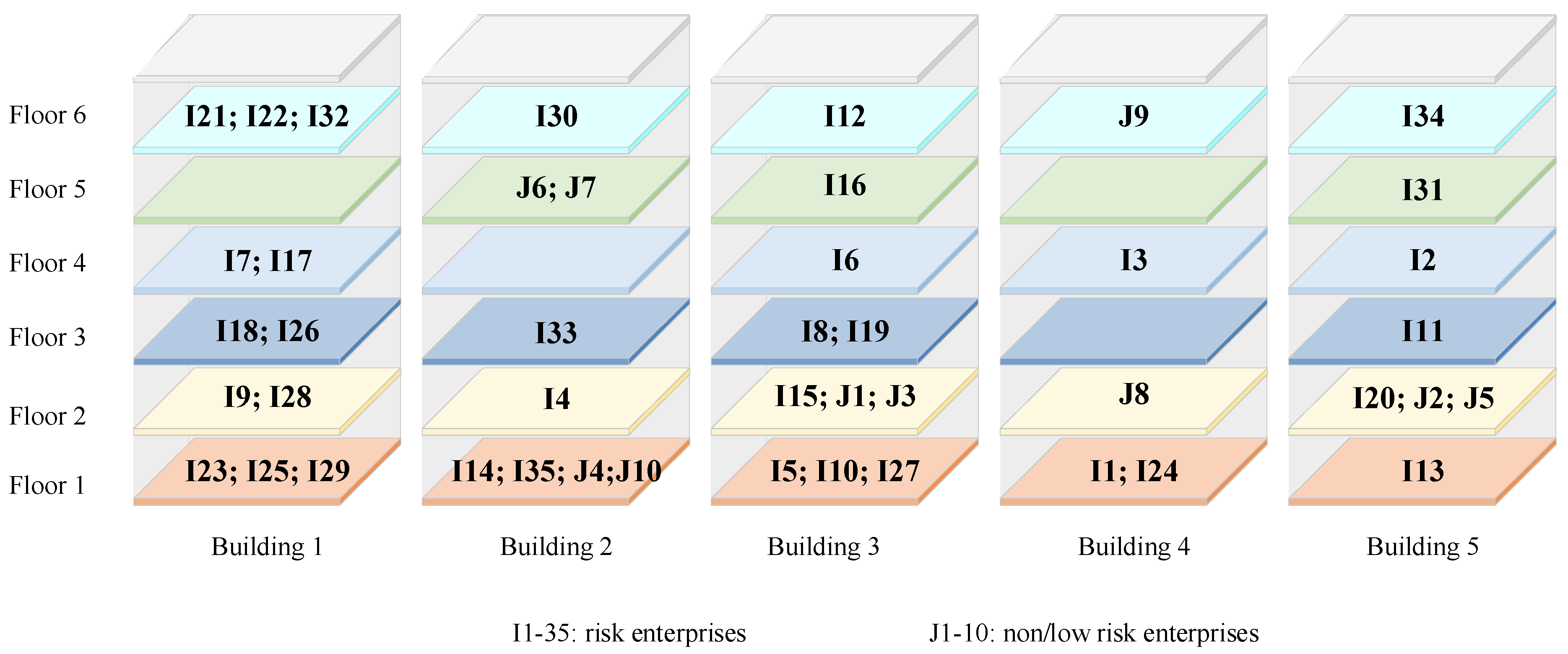
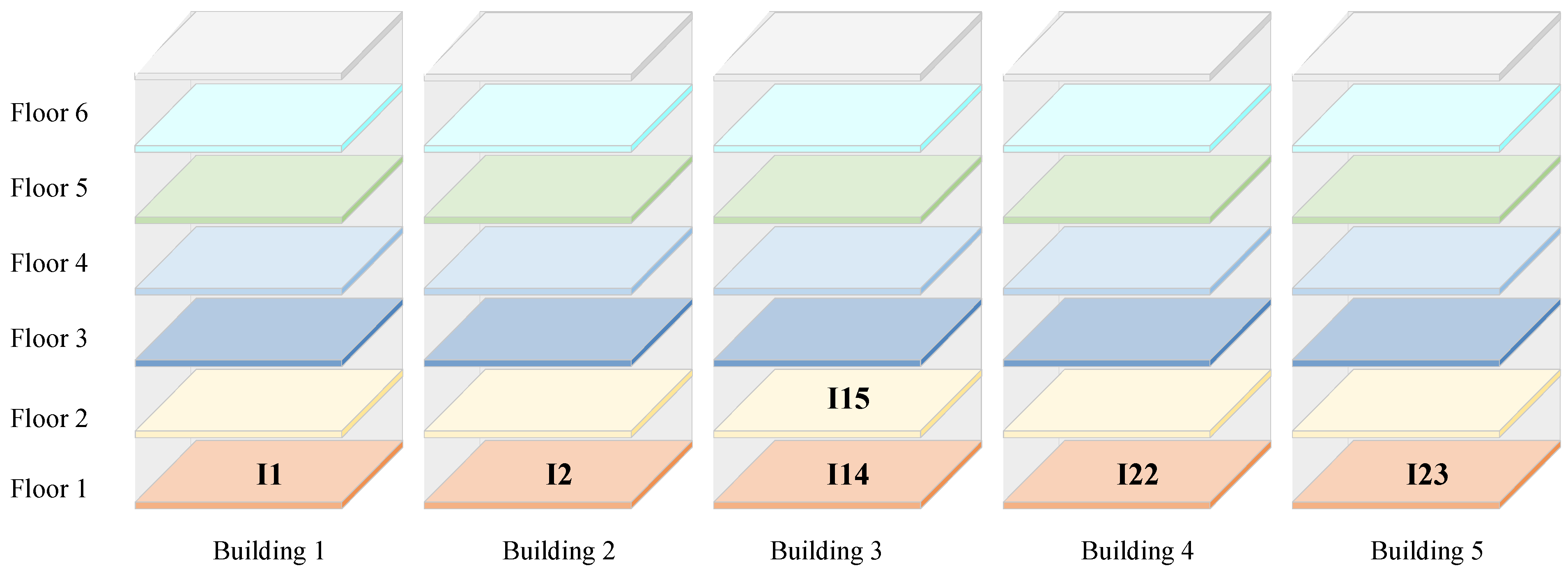

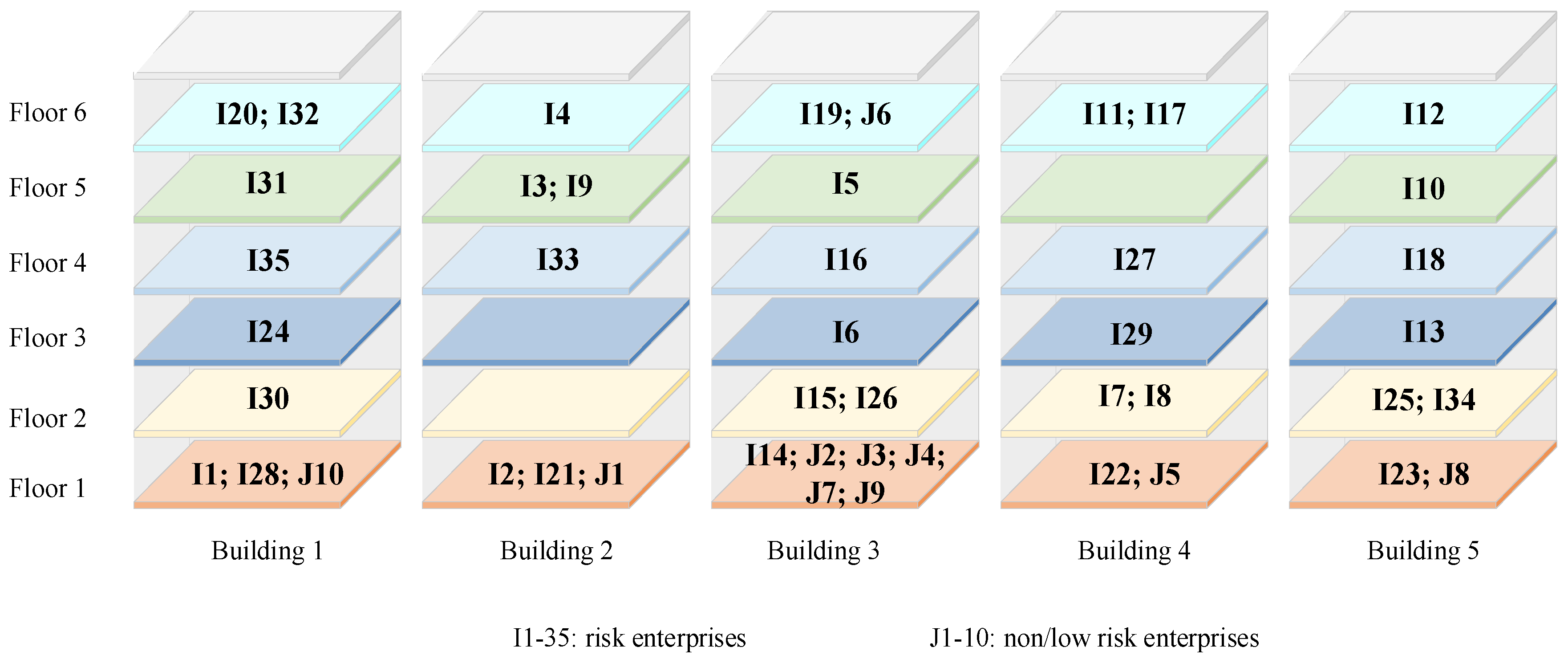


| Article | Main Problem | Multi-Story Layout | Risk | Profit | Cost * | Hierarchy | Approach |
|---|---|---|---|---|---|---|---|
| Balakrishnan [40] | Plant layout | No | No | No | Yes | Single | Heuristic |
| Patsiatzis [41] | Process plant layout | No | Yes | No | Yes | Single | Exact |
| Vázquez-Román [42] | Facility layout | No | Yes | No | Yes | Single | Exact |
| Cheng [43] | Facility layout | No | No | No | No | Single | Heuristic |
| Xu [44] | Chemical Plant Layout | No | Yes | No | Yes | Single | Heuristic |
| Emami [45] | Dynamic facility layout | No | No | No | Yes | Single | Heuristic |
| Medina-Herrera [20] | Plant layout | Yes | Yes | No | Yes | Single | Exact |
| Kia [9] | Dynamic cellular manufacturing systems layout | Yes | No | No | Yes | Single | Heuristic |
| Izadinia [46] | Multi-floor layout problem | Yes | No | No | Yes | Single | Exact |
| Caputo [3] | Process plant layout | No | Yes | No | Yes | Single | Heuristic |
| Alves [47] | Chemical plant layout | No | Yes | No | No | Single | Heuristic |
| Ahmadi [36] | Facility layout | Yes | No | No | Yes | Single | Exact |
| Wang [1] | Industrial area layout | No | Yes | No | Yes | Single | Heuristic |
| Che [32] | Facility layout | Yes | No | No | Yes | Single | Exact |
| Latifi [10] | Process plant layout | No | Yes | No | Yes | Single | Heuristic |
| Zhang [48] | Warehouse layout | No | No | No | Yes | Single | Heuristic |
| Arnaout [49] | Warehouse layout | No | No | No | Yes | Multiple | Heuristic |
| Wang [4] | Industrial park layout | No | Yes | No | Yes | Single | Heuristic |
| Şahin [6] | Facility layout | No | No | No | Yes | Single | Heuristic |
| Ejeh [24] | Process plant layout | Yes | Yes | No | Yes | Single | Exact |
| This study | Industrial park layout | Yes | Yes | Yes | No | Multiple | Heuristic |
| Building ID | Number of Floors | |
|---|---|---|
| 1 | 6 | 2332 |
| 2 | 6 | 3475 |
| 3 | 6 | 8211 |
| 4 | 6 | 2180 |
| 5 | 6 | 2934 |
Publisher’s Note: MDPI stays neutral with regard to jurisdictional claims in published maps and institutional affiliations. |
© 2022 by the authors. Licensee MDPI, Basel, Switzerland. This article is an open access article distributed under the terms and conditions of the Creative Commons Attribution (CC BY) license (https://creativecommons.org/licenses/by/4.0/).
Share and Cite
Liu, X.; Huang, G.; Gao, X.; Li, H.; Ou, S.; Hezam, I.M. Large-Scale 3D Multi-Story Enterprise Layout Design in a New Type of Industrial Park in China. Appl. Sci. 2022, 12, 8110. https://doi.org/10.3390/app12168110
Liu X, Huang G, Gao X, Li H, Ou S, Hezam IM. Large-Scale 3D Multi-Story Enterprise Layout Design in a New Type of Industrial Park in China. Applied Sciences. 2022; 12(16):8110. https://doi.org/10.3390/app12168110
Chicago/Turabian StyleLiu, Xuemin, Guozhong Huang, Xuehong Gao, Haoxuan Li, Shengnan Ou, and Ibrahim M. Hezam. 2022. "Large-Scale 3D Multi-Story Enterprise Layout Design in a New Type of Industrial Park in China" Applied Sciences 12, no. 16: 8110. https://doi.org/10.3390/app12168110








